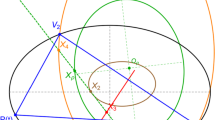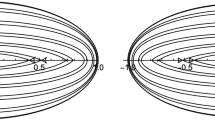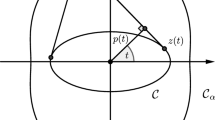Abstract
We study six pedal-like curves associated with the ellipse which are area-invariant for pedal points lying on one of two shapes: (i) a circle concentric with the ellipse, or (ii) the ellipse boundary itself. Case (i) is a corollary of properties of Steiner’s Curvature Centroid (Krümmungs-Schwerpunkt), proved in 1825. For case (ii) we prove area invariance algebraically. Explicit expressions for all invariant areas are also provided. Finally, we generalize the results for a class of smooth curves.











Similar content being viewed by others
Notes
After the actual Talbot’s Curve, shown in Fig. 1 (bottom): the negative pedal curve of an ellipse with respect to its center O.
References
Aguilar-Arteaga, V.A., Ayala-Figueroa, R., González-García, I., Jerónimo-Castro, J.: On evolutoids of planar convex curves II. Aequationes Math. 89(6), 1433–1447 (2015). https://doi.org/10.1007/s00010-015-0352-4
Ahlfors, L.V.: Complex Analysis: an Introduction to Theory of Analytic Functions of One Complex Variable. McGraw Hill, New York (1979)
Garcia, R., Reznik, D., Stachel, H., Helman, M.: A family of constant-areas deltoid associated with the ellipse. KoG 24, 12–28 (2020)
Giblin, P.J., Warder, J.P.: Evolving evolutoids. Am. Math. Mon. 121(10), 871–889 (2014). https://doi.org/10.4169/amer.math.monthly.121.10.871
Glaeser, G., Stachel, H., Odehnal, B.: The Universe of Conics: From the ancient Greeks to 21st century developments. Springer, New York (2016)
Jerónimo-Castro, J.: On evolutoids of planar convex curves. Aequationes Math. 88(1–2), 97–103 (2014). https://doi.org/10.1007/s00010-013-0213-y
Kimberling, C.: Encyclopedia of triangle centers. ETC (2019). https://faculty.evansville.edu/ck6/encyclopedia/ETC.html
Ostermann, A., Wanner, G.: Geometry by Its History. Springer, New York (2012)
Pamfilos, P.: Topics in geometry: Pedal polygons (2019). http://users.math.uoc.gr/~pamfilos/eGallery/problems/PedalPolygons.html
Steiner, J.: Über den Krümmungs-Schwerpunkt ebener Curven. Abhandlungen der Königlichen Akademie der Wissenschaften zu Berlin, pp. 19–91 (1838)
Weisstein, E.: Mathworld. MathWorld–A Wolfram Web Resource (2019). https://mathworld.wolfram.com
Acknowledgements
We would like to thank Robert Ferréol and Mark Helman for their help during this work. We are also grateful to the referee’s corrections and invaluable suggestions for improvement. The second author is fellow of CNPq and coordinator of Project PRONEX/ CNPq/ FAPEG 2017 10 26 7000 508.
Author information
Authors and Affiliations
Corresponding author
Additional information
Publisher's Note
Springer Nature remains neutral with regard to jurisdictional claims in published maps and institutional affiliations.
Appendices
Appendix A: Evolutoids
Some of the results in this section appear in Aguilar-Arteaga (2015); Jerónimo-Castro (2014). Consider a plane curve \({\mathcal {C}}(t)=[x(t),y(t)]\) defined by a support function h, see Eq. (4).
The family of lines passing through \(P(t)=[x(t),y(t)]\) making a constant angle \(\theta \) with \((x^\prime (t),y^\prime (t)) \) is given by:
Let \({\mathcal {C}}_\theta (t)=(x_\theta ,y_\theta )\) denote the envelope of \({\mathcal {L}}_\theta (t)\). This will be given by:
Note that \({\mathcal {C}}_{\pi /2}\) is the evolute of \({\mathcal {C}}\). Let \(h_{\theta }(t)=h(t-\theta )\cos \theta +h'(t-\theta )\sin \theta \). Changing variables \(t=t-\theta \) it follows that the envelope is given by
Let S(.) denote the signed area of a curve. Then
Proposition 8
\(S({\mathcal {C}}_\theta )\) is given by
Proof
The signed area of the evolute \({\mathcal {C}}_{\pi /2}\) is negative in general, and zero if \({\mathcal {C}}\) is a circle. Integrating Eq. 2 by parts and simplifying it yields the claim. \(\square \)
Let L(.) denote the perimeter of a curve.
Proposition 9
For small \(\theta \), \(L({\mathcal {C}}_{\theta }\)) is given by:
Proof
Let T, N define the tangent and normal axis of the Frenet frame. From Giblin and Warder (2014) we have that
Differentiating the above and using Frenet equations \(T'={k}N\) and \(N'=-{k}T\), it follows that
Therefore,
For small \(\theta \) it follows that
Integration leads to the result stated. \(\square \)
Appendix B: Table of symbols
See Table 1.
Rights and permissions
About this article
Cite this article
Reznik, D., Garcia, R. & Stachel, H. Area-invariant pedal-like curves derived from the ellipse. Beitr Algebra Geom 63, 359–377 (2022). https://doi.org/10.1007/s13366-021-00588-x
Received:
Accepted:
Published:
Issue Date:
DOI: https://doi.org/10.1007/s13366-021-00588-x




